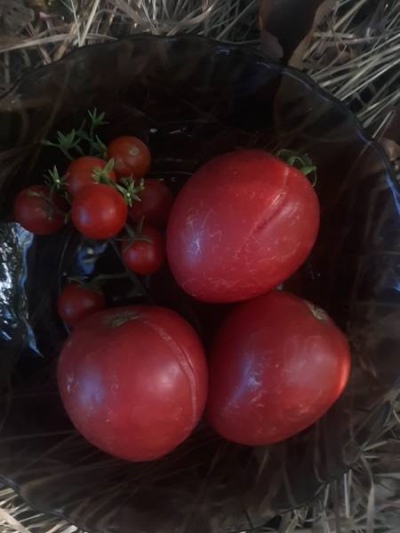
- Authors: Kandoba E. E., Kandoba A. V. (Premium Seeds LLC)
- Year of approval: 2020
- Category: hybrid
- Growth type: indeterminate
- Appointment: universal
- Ripening period: early
- Ripening time, days: 95-98
- Growing conditions: for open ground, for film greenhouses
- Transportability: high
- Bush height, cm: 180-200
Love and pigeons is a relatively new hybrid tomato variety, approved for use in 2020. In such a short time, the novelty has already been tested by many gardeners, who shared their impressions of the cultivation of this crop.
Description of the variety
The bush is indeterminate type, reaches a height of 180-200 cm. Slightly spreading, compact, with green leaves of medium length. The plant is characterized by inflorescences of an intermediate type, the stalk has an articulation.
The main qualities of the fruit
In an unripe state, tomatoes are green, ripe fruits have a raspberry color. Large in size, weight - 200 g, shape - heart-shaped, slightly ribbed. They are characterized by good transportability.
Taste characteristics
The pulp of the presented variety is medium in density, fleshy, sugary, and its main advantage is the absence of a white core, which facilitates the process of cutting a vegetable or eating it fresh.
It is believed that these tomatoes can be used for any culinary purposes, however, judging by consumer reviews, they are not suitable for whole-fruit canning due to their large size. But they make delicious vegetable caviar, lecho and other preparations. These tomatoes are perfect for making fresh vegetable salad.
Ripening and fruiting
Love and pigeons are early ripening varieties. So, with the appearance of the first shoots, the harvest is carried out after 95-98 days. Cleaning usually occurs between July and September.
Yield
On average, from 1 sq. m, 15-16 kg of vegetables can be removed, however, there is information that, subject to all the rules of agricultural technology, it is possible to get up to 18-20 kg of harvest from 1 sq. m.
The timing of planting seedlings and planting in the ground
Sowing is done in early March. This is a hybrid variety, so seeds will have to be purchased every year. The substrate can be bought or prepared by yourself by mixing garden soil, humus, black peat and sand in proportions of 2: 1: 1: 1. Planting and leaving consist of the following stages.
- Prepare the substrate container.
- Deepen the seeds 1-1.5 cm.
- Spray the soil with water from a spray bottle.
- Cover the top with plastic foil and place in a warm place (+ 23 ... +25 degrees).
- When the first shoots appear, remove the film.
- Continue watering the plants.
- Dive seedlings when two leaves appear.
- Temper young bushes a week before transplanting, increase the time spent outside every day.
- Plant the seedlings in your summer cottage. Bushes at the age of 50-55 days are ready for transplantation.

Growing tomato seedlings is an extremely important process, because it largely depends on whether the gardener can harvest at all. All aspects must be taken into account, from seedbed preparation to planting in the ground.
Landing scheme
Plant seedlings according to the scheme 3-4 plants per 1 sq. m, that is, there should be at least 50 cm between two specimens. This will ensure high yields at normal planting density.

Growing and caring
The presented variety can be grown both in the open field and in a film greenhouse. As necessary, the plant needs to be pinned. This variety also needs to be formed, the formation in 1 stem shows particular efficiency. Also, care consists in the following actions.
- Water the crop at least twice a week with lukewarm water.
- Feed the plant every 10-15 days. As a rule, complex mineral compositions are alternated with organic dressings. The most popular are bird droppings, mullein, herbal infusion.
- Loose and weed regularly.
- Apply a layer of mulch such as straw, hay, or sawdust. This will slow down the growth of weeds and protect the soil from moisture loss.
- When the bushes reach a length of 60-70 cm, tie them to the supports.




A plant needs different micronutrients at each stage of growth. All fertilizers can be divided into two groups: mineral and organic. Folk remedies are often used: iodine, yeast, bird droppings, eggshells.
It is important to observe the rate and period of feeding. This also applies to folk remedies and organic fertilizers.
Disease and pest resistance
The hybrid has proven to be resistant to ailments such as Alternaria and Tobacco Mosaic Virus, but the plant can rot. As a preventive measure, observe the watering regime, try not to overfill the crop, and a few days after planting in open ground, treat the shoots with fungicides, for example, with Hom, Fundazol, Skor.
Of the insects, the presented variety can be chosen by spider mites, aphids, nematodes. From these pests, infusions of tobacco dust, wood ash, garlic, and onion husks help well. In advanced cases, serious insecticides are used, such as Aktara, Fufanon, Biotlin. Processing is carried out in the evening, in dry, calm weather.



























































































